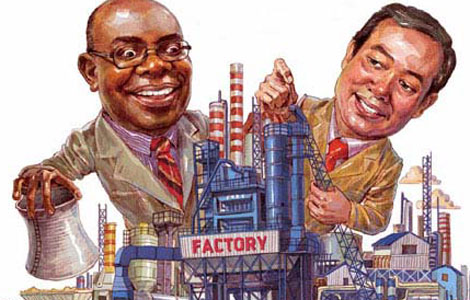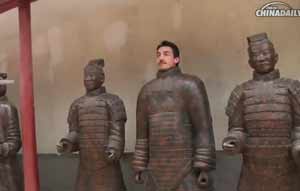Slowing growth no cause for concern
Updated: 2013-07-19 09:22
By Zheng Yangpeng (China Daily)
|
|||||||||||
|
Yukon Huang, former World Bank country director for China, says "trial and error" method could be used in China's development. Sun Chenbei / China Daily |

Urbanization important for china to maintain steady economic progress
Seven percent is a reasonable GDP growth rate for China and provides ample room for further institutional reform, says Yukon Huang, a noted expert on financial and development issues for emerging markets.
"I think the government is quite right to say our target growth rate for this decade is 7 percent, not 8 percent. They could be a bit relaxed right now because the economy is actually growing at 7.7 to 7.8 percent," says Huang, a senior associate at the Washington-based Carnegie Endowment for International Peace.
Huang, who is considered to be an expert on East Asia, particularly China, feels that though economic growth will taper off in the long run, there is no cause for concern.
"The central government can be relaxed because the economic growth floor is 7 percent. In the past, the floor never made much sense, as economic growth in China was always far above the floor. It is only now that the floor is becoming more meaningful," he says.
Huang, who was also the World Bank's country director for China from 1997 to 2004, says monetary expansion alone will not solve China's economic woes, given the recent contradiction between the surge in money supply and sluggish economic growth.
Explaining the reasons behind the dampened real credit demand, he says: "The banks are flush with funds. Several big companies are sitting on piles of money generated from internal resources. They don't really need to borrow for expansion. Inventory level in China is relatively high and companies do not feel any urgent need to expand capacity. Some people do want to borrow for property speculation, but the government is trying to control that."
In addition, China's local governments are under severe financial strain due to their excessive spending during the earlier stimulus program. Property credit and investment are also restricted. So the credit expansion did not generate too many activities, Huang says.
By the end of June, China's broad money supply (M2) grew by 14 percent over a year ago to reach 105 trillion yuan ($17 trillion; 13 trillion euros), or 200 percent of the GDP. However, GDP growth eased to 7.7 percent in the first quarter and is expected to remain weak in the second quarter.
"What does it tell the government? Monetary expansion is not going to solve the problem. I think the government is quite correct to put reform issues on the agenda, including overhaul of the financial system, hukou (household registration) system reform, urbanization, and liberalization, and streamlining of the administrative procedures.
"But the real problem is, whether the reforms will have a short-term impact on the economy. If structural reform is beneficial to medium and long-term growth, then the question is how soon will it take effect?"
He says it should be recognized that, since the Chinese economy is a maturing economy, the growth has started to moderate.
"If you look at South Korea or other economies, you will see that most of them have slowed down after attaining the high-income status. So China's slow down is not a problem. The real question is how fast does China need to grow to achieve the high-income status?" he says.
"Of course the government doesn't want to slow down prematurely. For the rest of this decade, China needs to grow at 7 to 8 percent. It can afford to grow at 5 to 6 percent from 2020 through 2030. By then it would also have become a high-income and the largest economy in the world."
But can China grow at 7 percent or a little more for the next seven years? "The economy does not have any fresh impetus like in the past when the entry into the World Trade Organization provided the stimulus. China can no longer export its goods to the US and Europe as it used to in the past due to the depressed global market conditions."
This is also why China's urbanization program is an important facet in its development, Huang says.
"When the premier talks about urbanization, he is talking about something different from the past. You cannot think of urbanization as just building more. That's dangerous. The critical question is how to achieve sustainable demand through urbanization."
There are many aspects of China's urbanization that can become sustainable, he says.
For example, Huang says, though the country's commercial housing development got a boost in the past decade, government-subsidized affordable housing remains insufficient.
"You need to figure out a way to build affordable rental housing that is financially sustainable. It is not being done because builders don't find it profitable. But the reason is the way the land is being managed in these cities make it a high cost affair.
"Fifty to 60 percent of the urban housing stock is what I call old socialist housing. That land is potentially usable for affordable housing. The problem right now is that they are developed by city officials in ways that often lead to inappropriate practices and excessively high prices."
Huang says the right way is for owners of these houses and condos to partner with builders and share the process so that both sides are happy. City officials will make more money by levying construction tax and property tax.
The present practice in China is that land or old buildings have to be taken over by government before they are developed. Owners are offered compensation, which is often regarded by many as too low. Mandatory resettlements often lead to social grievance.
"Right now it is not possible for the owner of a socialist stock building and the tenant to actually develop the building.
"They don't benefit from the process, so they don't want to resettle. This is not an appropriate model to develop affordable housing. Besides, a majority of the affordable houses should be rental, and not for purchase. If you do this, you generate continued construction which is sustainable."
Huang, a Chinese American who routinely travels between Washington and Beijing, says that there is also enormous demand to improve public transport in China's urbanization program.
"I often tell people that Beijing is actually too small, and is not as densely populated as it should be. In fact, it has only about half the density when compared with other major Asian cities.
"You look around Beijing, and you see a lot of land that is unutilized or half utilized. They are mostly held by state-owned enterprises or are socialist housing for employees. Once they are redeveloped, considerable room could be made for affordable houses."
Huang also believes that China Central Television should not be located in Beijing's CBD.
"That's not the appropriate way to use that land. You don't expect crowds to come to CCTV. That location should be for (buildings that attract) heavy traffic. Broadcasting stations are never located in the central parts of the city."
However, he adds that "trial and error" method could be used in China's development.
"Take the country's shadow banking system for example, which recently triggered considerable concerns. I would argue that it has had positive consequences.
"More money is pumped into the private sector, and it makes the interest rate more flexible. Lenders and borrowers are also more familiar with risks. Of course there will be some lenders who will lose huge amounts of money and borrowers who will waste it. Hopefully both sides will learn and become more sophisticated. Five years from now, we may have a much more market-driven, private sector-oriented lending system.
"This is part of China's strength. Experiment, pilot, modify and go on. Learn from the experiences and make sure that your costs are not wasted."
zhengyangpeng@chinadaily.com.cn
(China Daily European Weekly 07/19/2013 page32)
Today's Top News
List of approved GM food clarified
ID checks for express deliveries in Guangdong
Govt to expand elderly care
University asks freshmen to sign suicide disclaimer
Tibet gears up for new climbing season
Media asked to promote Sino-Indian ties
Shots fired at Washington Navy Yard
Minimum growth rate set at 7%
Hot Topics
Lunar probe , China growth forecasts, Emission rules get tougher, China seen through 'colored lens', International board,
Editor's Picks

|

|

|

|

|

|






